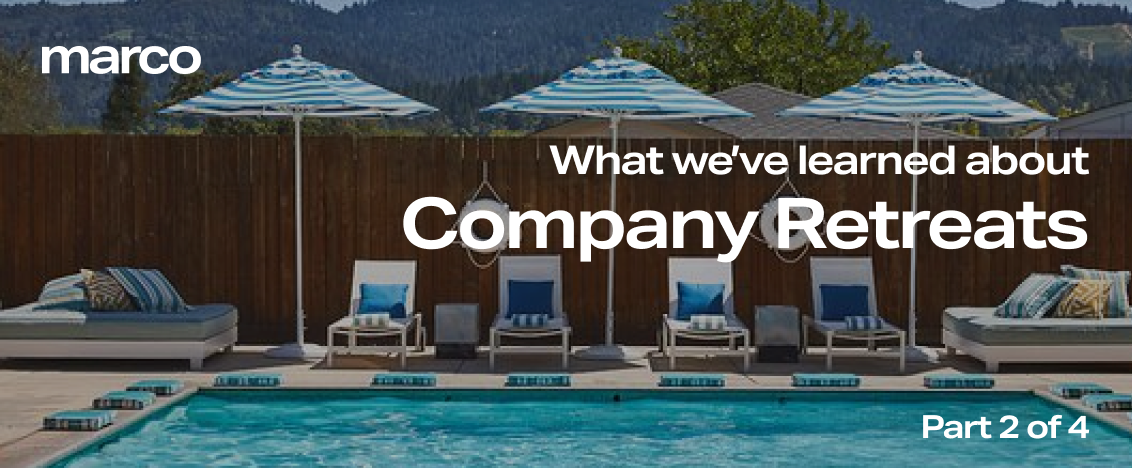Three must-know steps before you start planning a retreat: part 2 of 4
While planning a retreat is a logistical feat (as described in the last installment of our Marco Retreats series), it doesn’t have to be daunting. Yes, you need to give yourself an adequate amount of time (step 0), but everything will fall into place if you kick off the process with three simple steps.

Before you start planning your company retreat, make sure you take three critical steps:
- Understand what actually goes into planning a retreat
- Decide if you can do this in-house of if you need to bring in an expert for support
- Partner with the right expert
Dive into what these three steps really mean below. And if you're ready to talk to someone about your upcoming retreat, book time!
Step 1
Understand what goes into planning a retreat
In our Marco Retreats Framework, a Retreat has four distinct parts:
1. THE VISION
Why bring the team together? Why now? What is the intention?
Having specific goals for your retreat will help you understand how to plan it. This could be meaningful connection — with the goal of creating connectivity through meaningful and fun experiences, with less time spent in meetings and on purely work projects. Another option is a combination of work and play. On this type of retreat, your team can make time for meaningful connection through experiences, alongside dedicated time for meetings and achieving more work-related goals. All of these considerations heavily influence the the next part— the logistics.
2. THE LOGISTICS
Who and how many?
Will it be the whole company or just a subset of teams? Once you know the size of your group, it’ll be easier to plan other aspects of your retreat — like understanding what kind of venue you’ll need, what types of activities to plan, and more.
When?
Make sure your team is aligned on at least a ~2 week window. Having a time frame to work within can help you understand what’s available, while also leaving room for venue or accommodations flexibility.
Where?
Northeast or southwest? US or international? Beach or woods? Know where most of your team is and what makes the most sense for the group before you get started (we can help you figure this out!).
3. THE BUDGET
It’s important to understand what resources are available, but even more, the breakdown of those resources. A retreat can be broken into four main parts:
- STAY & GATHER: accommodations and meeting spaces
- EAT & DRINK: food and beverage
- EXPERIENCE: activities and facilitators
- TRAVEL & LOGISTICS: airfare and ground transport
We’ve built a comprehensive framework and budget breakdown for our retreats customers and we fully handle 1-3. While we don’t book your travel, we help you track it, budget for it, and build it out.
4. THE DETAILS
The details are everything else. From the larger aspects, like the daily itinerary and figuring out how to skirt the food & beverage minimums, to the smaller details, like the dietary restrictions and the branded napkins and the AV set up in the meeting spaces.
The institutional knowledge that a partner like Marco can bring to the table has an immeasurable impact on the success of the retreat—specifically when it comes to the details. Which leads us to step 2...
Step 2
Plan it fully in-house vs. bring on a partner
If your company has an in-house events planner or a robust internal events team...
You're probably set up to plan your retreat in-house. Here are a couple things to consider about bringing on a dedicated retreats planner, even if you are staffed up:
- Given the state of the world, retreat properties are booking up months—sometimes years—in advance. A partner like Marco has relationships with these destinations and better access to popular venues... even if they are listed as booked up.
- Your events planners are likely juggling a number of events—from happy hours to off-sites to leadership summits, not to mention all of the client and sales events. Teams rely on tools. Marketers use Hubspot or Marketo. Sales teams use Gong and Salesforce. Why shouldn't your events team get a tool to streamline their efforts?
And if you don't have dedicated in-house events planners...
Just remember that whoever has been tasked with planning this retreat has a separate full-time job. On average, Marco saves companies >80 internal hours in the planning of 1 retreat.
Step 3
Partner with the right expert
If you've diagnosed that you want to enlist a partner in planning your next retreat, be picky when deciding. Here are a few things to look out for when finding the right partner:
- Does the partner have a solid planning framework that you trust?
- Will you be this partner's priority, and not just one of 100?
- Do they have access to the best and most relevant properties, and are they willing to show you the inventory before signing a contract?
And many more—but those three questions are a good place to start.
Stay Tuned.
Stay tuned for the next part of our Retreats Series, dropping next week. We'll dive into the Marco Retreats Framework—including the full process from first inquiry to post-retreat surveying, and a couple case studies.
Ready to go?
If we’ve successfully convinced you to get started, and that partnering with Marco might just be a good idea, book time with one of our Retreats specialists today. You’ll be prompted to fill out a very brief survey before booking time so we can come to the call knowing your needs and ensure that our conversation efficient and effective.
